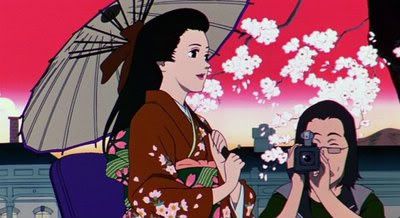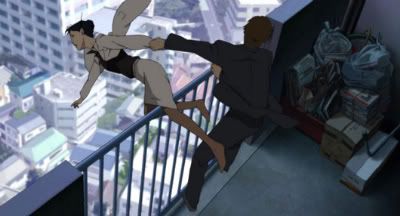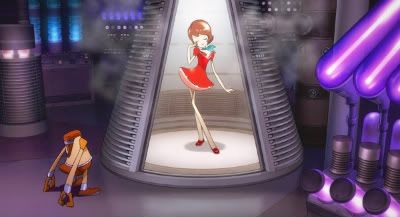
I generally try to space out my posts about animation, one of my favorite subjects, for fear of narrowing the scope of this blog too much. I posted about the rumored similarities between the anime "Perfect Blue" and Darren Aronofsky's "Black Swan" just two days ago, but I need to break the rule now. We just lost a major talent in the animation world. Satoshi Kon, the writer and director of the anime films "Perfect Blue" (1996), "Millennium Actress" (2001), "Tokyo Godfathers" (2003), "Paprika" (2006), the upcoming "The Dream Machine" (2011) and the television series "Paranoia Agent" (2004) passed away yesterday at the age of 46. His death was sudden, and details are still forthcoming, but he apparently lost a battle with cancer that few of his fans were aware of.
Satoshi Kon was one of the animation greats despite his relatively young age. He's not as well known as Studio Ghibli's Hayao Miyazaki, but he's easily as important. Kon had a singular, instantly recognizable visual style that had greater verisimilitude than most of his contemporaries. This allowed him to tackle dramatic stories grounded in the real world that were rarely done in animation. Many of his films like "Perfect Blue" and "Tokyo Godfathers" could have been made in live action, but the fact that they were animated allowed him to blur realities within his narratives, and include fantasy elements with a seamlessness that would be impossible in live action. "Millennium Actress" followed a celebrated actress from her schoolgirl days to old age, every stage of her life perfectly brought to the screen without the distracting complications of make-up and CGI. He used animation in ways that no one else did, told stories with it in ways that no one else had tried, often with magnificent results.

One of the hallmarks of his stories was the use of ambiguous and shifting frames of reference. One of his lovely heroines might appear in her childhood home, and then open a door and walk out into a movie studio, revealing everything we saw was on a film set. Or physically revisit old memories by walking into different rooms to join the tableaux of the past within, moving from one to another at will. Or have conversations with a doppelganger projection of herself that represented an earlier persona. Or drop an assumed identity by literally shedding it like a snake skin. Technically, he worked at a level equal to any live action filmmaker you could name, and his penchant for reality-bending brought comparisons to the films of Darren Aronofsky, Christopher Nolan, and others who took on similar material. I still can't find a credible source for the claim that Aronofsky bought the remake rights for "Perfect Blue" so he could recreate a sequence in "Requiem for a Dream," but I wouldn't be surprised if he had.
Kon's biggest accomplishment was that he succeeded in bringing anime down to earth in a way that made it accessible to non-anime fans, especially grown-ups. Even in his wildest flights of fancy, such as the dream-hopping fantasia of "Paprika," his characters always looked and behaved like regular human beings, with a certain real-world gravity about them. The stylistic excesses often associated with anime were almost wholly absent from his earlier features, and often satirized in his later work. He explored multiple genres, including comedy in "Tokyo Godfathers," a murder mystery in "Perfect Blue," romance in "Millennium Actress," science-fiction in "Paprika," and blended all of them and more for the various installments of "Paranoia Agent." As Kon racked up festival awards and heaps of good press, larger studios like Dreamworks and Sony took notice and distributed several of his films in the US as serious prestige pictures, a rare distinction for anime. He was one of the very few animation directors who truly transcended his chosen medium.

Ironically his unfinished "The Dream Machine" would have been his first children's film, and the first to star non-human characters. He described it in interviews as a fantasy-adventure road movie about robots. At the time of writing, there is no word from Madhouse, the studio where Kon made all his pictures, when or if "Dream Machine" will be completed. The abruptness of Kon's departure may leave the film in limbo, and underscores the bitterness of the anime community's loss. Kon's legacy is assured with the work he leaves behind, but his career was all too brief. His directorial debut, "Perfect Blue," was only fifteen years ago. It's hard not to wonder what other genre-bending, boundary-pushing wonders Kon might have produced if he'd had another fifteen years, or even five.
But there's no use dwelling on what might have been. Satoshi Kon left us with four feature films, another in progress, thirteen episodes of "Paranoia Agent," assorted shorts, and some notable contributions to other projects, including the script for the "Magnetic Rose" segment of the criminally underseen 1995 anthology feature "Memories." My favorite, and the one I can't help thinking of now, is the eighth episode of "Paranoia Agent," titled "Happy Family Planning." A very black comedy, it follows three people who are determined to commit suicide together, but keep being foiled in their attempts. I enjoyed it for its absurdity and dark humor, but I also liked how Kon treated the subject of death, as something natural and eventual and maybe not such a big deal in the end. Death brings three lonely strangers together, and I hope it might help to bring Satoshi Kon's work to greater prominence. Too few people know him and the anime he created.
They don't know what we've just lost.
---

No comments:
Post a Comment